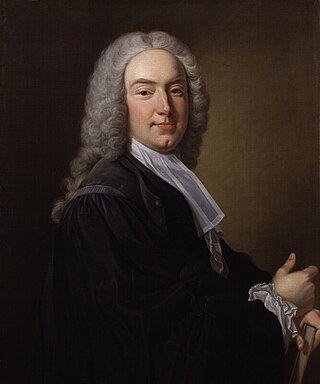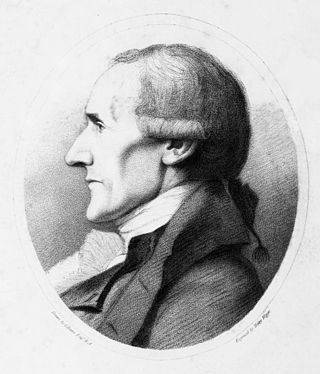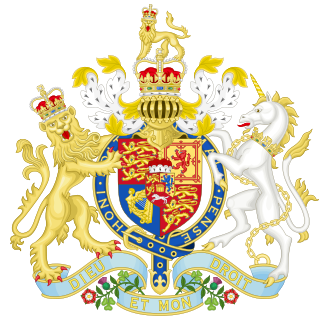Related Research Articles

Abolitionism, or the abolitionist movement, is the movement to end slavery and liberate slaves around the world.

William Wilberforce was a British politician, a philanthropist, and a leader of the movement to abolish the slave trade. A native of Kingston upon Hull, Yorkshire, he began his political career in 1780, and became an independent Member of Parliament (MP) for Yorkshire (1784–1812). In 1785, he underwent a conversion experience and became an Evangelical Anglican, which resulted in major changes to his lifestyle and a lifelong concern for reform.

William Murray, 1st Earl of Mansfield, PC was a British barrister, politician and judge noted for his reform of English law. Born to Scottish nobility, he was a member of the Scottish Clan Murray and was educated in Perth, Scotland before moving to London at the age of 13 to take up a place at Westminster School. He was accepted into Christ Church, Oxford, in May 1723, and graduated four years later. Returning to London from Oxford, he was called to the Bar by Lincoln's Inn on 23 November 1730, and quickly gained a reputation as an excellent barrister.

Granville Sharp was a British scholar, devout Christian, philanthropist and one of the first campaigners for the abolition of the slave trade in Britain. Born in Durham, he initially worked as a civil servant in the Board of Ordnance. His involvement in abolitionism began in 1767 when he defended a severely injured slave from Barbados in a legal case against his master. Increasingly devoted to the cause, he continually sought test cases against the legal justifications for slavery, and in 1769 he published the first tract in England that explicitly attacked the concept of slavery.

The Slave Trade Act 1807, officially An Act for the Abolition of the Slave Trade, was an Act of the Parliament of the United Kingdom prohibiting the slave trade in the British Empire. Although it did not abolish the practice of slavery, it encouraged British action to press other nation states to abolish their own slave trades. It took effect on 1 May 1807, after 18 years of trying to pass an abolition bill.

The Zong massacre was a mass killing of more than 130 enslaved African people by the crew of the British slave ship Zong on and in the days following 29 November 1781. The William Gregson slave-trading syndicate, based in Liverpool, owned the ship as part of the Atlantic slave trade. As was common business practice, they had taken out insurance on the lives of the enslaved Africans as cargo. According to the crew, when the ship ran low on drinking water following navigational mistakes, the crew threw enslaved Africans overboard.

Ottobah Cugoano, also known as John Stuart, was an abolitionist, political activist, and natural rights philosopher from West Africa who was active in Great Britain in the latter half of the 18th century.

The Slavery Abolition Act 1833 was an Act of the Parliament of the United Kingdom which provided for the gradual abolition of slavery in most parts of the British Empire. It was passed by Earl Grey's reforming administration and expanded the jurisdiction of the Slave Trade Act 1807 and made the purchase or ownership of slaves illegal within the British Empire, with the exception of "the Territories in the Possession of the East India Company", Ceylon, and Saint Helena. The Act came into force on 1 August 1834, and was repealed in 1998 as a part of wider rationalisation of English statute law; however, later anti-slavery legislation remains in force.

Dido Elizabeth Belle was a free black biracial British gentlewoman. She was born into slavery and illegitimate; her mother, Maria Belle, was an enslaved Black woman in the British West Indies. Her father was Sir John Lindsay, a British career naval officer who was stationed there; later knighted and promoted to admiral. Lindsay took Belle with him when he returned to England in 1765, entrusting her upbringing to his uncle William Murray, 1st Earl of Mansfield, and his wife Elizabeth Murray, Countess of Mansfield. The Murrays educated Belle, bringing her up as a free gentlewoman at their Kenwood House, together with another great-niece, Lady Elizabeth Murray, whose mother had died. Lady Elizabeth and Belle were second cousins. Belle lived there for 30 years. In his will of 1793, Lord Mansfield provided an outright sum and an annuity to her.
Slavery at common law in the British Empire developed slowly over centuries, and was characterised by inconsistent decisions and varying rationales for the treatment of slavery, the slave trade, and the rights of slaves and slave owners. Unlike in its colonies, within the home islands of Britain, until 1807, except for statutes facilitating and taxing the international slave trade, there was virtually no legislative intervention in relation to slaves as property, and accordingly the common law had something of a "free hand" to develop, untrammelled by the "paralysing hand of the Parliamentary draftsmen". Two attempts to pass a slave code via Parliament itself both failed, one in the 1660s and the other in 1674.
James Somerset was an African man and the plaintiff in a pivotal court case that confirmed that slavery was illegal in England and Wales.

Cesar Picton was a British merchant of West African descent. Born in Africa, he was sold into slavery and subsequently brought to England by a British Army officer in 1761 and given as a servant to Welsh politician and lawyer Sir John Philipps, 6th Baronet. Picton eventually left the Philipps' family service and became a wealthy coal merchant in Kingston upon Hull.

Slavery in Britain existed before the Roman occupation and until the 11th century, when the Norman conquest of England resulted in the gradual merger of the pre-conquest institution of slavery into serfdom, and all slaves were no longer recognised separately in English law or custom. By the middle of the 12th century, the institution of slavery as it had existed prior to the Norman conquest had fully disappeared, but other forms of unfree servitude continued for some centuries.
The Fugitive Slave Clause in the United States Constitution, also known as either the Slave Clause or the Fugitives From Labor Clause, is Article IV, Section 2, Clause 3, which requires a "Person held to Service or Labour" who flees to another state to be returned to his or her master in the state from which that person escaped. The enactment of the Thirteenth Amendment to the United States Constitution, which abolished slavery except as a punishment for criminal acts, has made the clause mostly irrelevant.
Somerset v Stewart (1772) 98 ER 499 is a judgment of the English Court of King's Bench in 1772, relating to the right of an enslaved person on English soil not to be forcibly removed from the country and sent to Jamaica for sale. According to one reported version of the case, Lord Mansfield decided that:
The state of slavery is of such a nature that it is incapable of being introduced on any reasons, moral or political, but only by positive law, which preserves its force long after the reasons, occasions, and time itself from whence it was created, is erased from memory. It is so odious, that nothing can be suffered to support it, but positive law. Whatever inconveniences, therefore, may follow from the decision, I cannot say this case is allowed or approved by the law of England; and therefore the black must be discharged.

Abolitionism in the United Kingdom was the movement in the late 18th and early 19th centuries to end the practice of slavery, whether formal or informal, in the United Kingdom, the British Empire and the world, including ending the Atlantic slave trade. It was part of a wider abolitionism movement in Western Europe and the Americas.

Commonwealth v. Aves, 35 Mass. 193 (1836), was a case in the Massachusetts Supreme Judicial Court on the subject of transportation of slaves to free states. In August 1836, Chief Justice Lemuel Shaw ruled that slaves brought to Massachusetts "for any temporary purpose of business or pleasure" were entitled to freedom. The case was the most important legal victory for abolitionists in the 1830s and set a major precedent throughout the North.

Bury the Chains: Prophets and Rebels in the Fight to Free an Empire's Slaves is a non-fiction book by Adam Hochschild that was first published by Houghton Mifflin on January 7, 2005. The book is a narrative history of the late 18th- and early 19th-century anti-slavery movement in the British Empire. The story centers around a group of British abolitionist campaigners and traces their campaign from its beginnings with Somerset v Stewart in 1772 until full emancipation for all British slaves was legally granted in 1838. The book looks at the setbacks the abolitionists faced as well as the campaign tactics they used, and explains how they were ultimately able to end the practice of slavery in Britain.
Betto Douglas was a slave on St. Kitts, at the time a British Colony. What is known of her life illuminates the practice slavery in the Caribbean and the efforts of abolitionist societies to free them. Douglas is an iconic figure of resistance to slavery in the country and her story is featured in the National Museum of Saint Kitts and Nevis. In Britain, she is included on the initial slave register for St. Kitts and kept in the Central Slave Registries at the British National Archives, which are enrolled in the UNESCO Memory of the World Registry.

Jonathan Strong was an enslaved person and subject of one of the earliest legal cases relating to slavery in Britain and the British abolitionist movement.